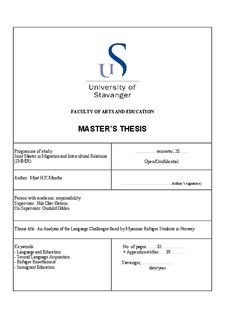| dc.contributor.author | Munthe, Myat | |
| dc.date.accessioned | 2012-03-29T08:08:58Z | |
| dc.date.available | 2012-03-29T08:08:58Z | |
| dc.date.issued | 2011 | |
| dc.identifier.citation | UIS | no_NO |
| dc.identifier.uri | http://hdl.handle.net/11250/185737 | |
| dc.description | Master's thesis in Migration and Intercultural Relations | no_NO |
| dc.description.abstract | This study aims to increase understanding the level of language proficiency and educational achievement for the first-generation immigrant students. The research provides an obligating account of the lives, dreams, and frustrations of Myanmar refugee students who arrive here at a later stage of their schooling. The intention with this study is to collect information from this particular group in order to understand the challenges they faced in their schooling. Thus, I counted not only on their arrival age, but also individual conditions from the background of previous education, language skills, and support from community. School and parents are considered as the important factors for the educational achievement. This research examines the link between the level of language proficiency and educational achievement, focus on school system and educational policies. Though determining a fact from the theories and research data revealed that Norwegian language is a key factor for the educational achievement. Additionally, findings show that although differences in individual student characteristics partially explain variation in level of language proficiency, however, the Norwegian school system and educational policies are also taking important role to create the educational gap between immigrant students and native. Thus, many refugee students will experience an ongoing need for support beyond the practical matters and students with language issues will need ongoing monitoring and support within the school’s existing welfare structures. This may include help for psychological problems that related to the effects of trauma in their past. These findings also demonstrate that the implementation of such measures hampered by their dependence on the human resources available. Final conclusion can be drawn that school system and curriculum need to implement and develop that make more responsive to the needs of immigrant students. Diversity must be put on the agenda and based on a source of enrichment within schools and localities, funding strategies, and monitoring and evaluation. | no_NO |
| dc.language.iso | eng | no_NO |
| dc.publisher | University of Stavanger, Norway | no_NO |
| dc.relation.ispartofseries | Masteroppgave/UIS-HF-IAS/2011; | |
| dc.subject | immigration | no_NO |
| dc.subject | refugee resettlment | no_NO |
| dc.subject | integration | no_NO |
| dc.subject | language | no_NO |
| dc.subject | migrasjoner | no_NO |
| dc.subject | interkulturelle relasjoner | no_NO |
| dc.subject | second language acquisition | no_NO |
| dc.subject | immigrasjon | |
| dc.subject | flyktninger | |
| dc.subject | språklæring | |
| dc.subject | Burma | |
| dc.title | An analysis of the language challenges faced by Myanmar refugee students in Norway | no_NO |
| dc.type | Master thesis | no_NO |
